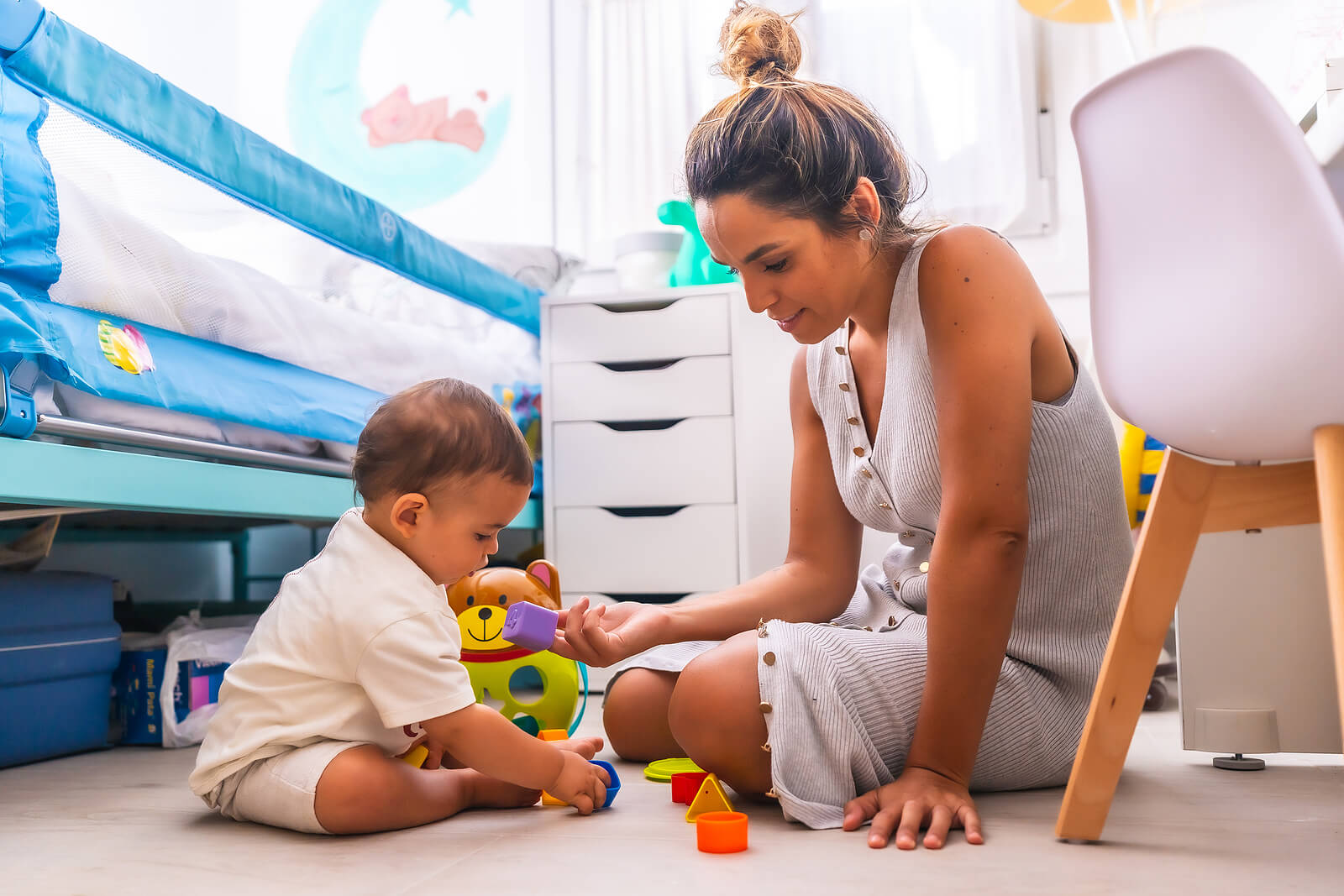Free-Play Activities for Children from 0 to 3 Years of Age


Written and verified by the pedagogue and trainer María Matilde
The first years of a child’s life are fundamental from the point of view of their development, and the main strategy to favor this development is through play. Therefore, both at home and at school, experiencing free-play activities will help children to mature and develop their full potential.
What are free-play activities?
Free play is the fundamental activity in the infant stage, as play for children isn’t just entertainment, but a way to explore and learn from the environment. For the youngest children, play means contact with and learning through the objects and people around them.
However, to speak of free-play activities means that it’s the children themselves who choose how to play. In other words, adults provide children with different objects, materials, and games that are appropriate to their ages. And it’s the children themselves who decide what to play, how long, and in what way.

Therefore, through free and spontaneous play activities, with objects according to their evolutionary stage and in adequate and safe spaces, children can play of their own free will. This way, children interact and interpret reality, developing their cognition and language and improving their motor skills.
“All the most important learning in life is done by playing.”
-Francesco Tonucci
Free-play activities for children from 0 to 3 years old
There are different types of free-play activities and each of them helps the development of a specific area of the child’s maturity. Therefore, some free-play activities and examples are listed below and the skills and abilities that the activity helps to develop are highlighted.
Board games
This type of activity encourages children to develop fine motor skills. Games such as dominoes, puzzles, or any other activity to fit or arrange pieces or blocks are ideal for cognitive-motor development.
Symbolic play
This is a fundamental play activity in the 0 to 3 years stage because symbolic play for the little ones signifies the imitation or evocation of real-life situations.
Therefore, children fantasize about everyday situations, such as being moms and dads, cooking time, or shopping, while learning expressive, affective, and social skills.
Motor play
Just as board games help develop fine motor skills, motor games help develop gross motor skills. Therefore, jumping rope, playing with balls, or riding a bike are perfect games in this sense because they influence the improvement of balance development and spatial-temporal orientation.
Manipulative play
Any activity in which children manipulate objects is positive for their development. Objects such as pencils, plasticine, stones, wooden blocks, counters, or cards are valid; all those materials that allow little ones a totally free play. From them, they progressively improve in fine motor skills, logical-mathematical, and sensory skills.
Play with puppets and costumes
Puppets and costumes entertain young children a lot. And, as with symbolic play, this type of activity influences the development of their social skills and emotional learning. Because children can play by representing situations that combine real life with their fantasies and dreams.
To carry out play activities with puppets or costumes, elements such as parents’ or grandparents’ clothes are ideal, as well as building the puppets with recycled material.
Play with stories and tales
Reading short stories and tales is an ideal activity for the progressive development of language and oral expression in children. Therefore, throughout the stage from 0 to 3 years old, little ones, through stories, learn new vocabulary, the pronunciation of their first words, and to emit onomatopoeias, until they’re able to say complete sentences. They also learn to use pronouns and plurals.
In addition, it’s important that children get used to listening to stories, as this is the first step towards teaching them the habit of reading.

“Nothing fires a child’s mind like playing.”
-Dr. Stuart Brown-
The importance of play in child development
Play is the fundamental strategy for the learning and development of children. Through play, they allow their imagination, creativity, and personality to express themselves. At the same time, they develop motor and physical, cognitive, and emotional skills.
In addition, through play activities, children become more complex in their interaction with others, and therefore, in their socialization. Through play, children also interact with their entire material and physical environment and thus learn spatial notions for an adequate use and mastery of space.
Therefore, as children grow and their maturity demands it, directed activities and games will be more appropriate. But in the first years of children’s lives, free-play activities are the most appropriate as they allow little ones to progress satisfactorily in their overall development.
The first years of a child’s life are fundamental from the point of view of their development, and the main strategy to favor this development is through play. Therefore, both at home and at school, experiencing free-play activities will help children to mature and develop their full potential.
What are free-play activities?
Free play is the fundamental activity in the infant stage, as play for children isn’t just entertainment, but a way to explore and learn from the environment. For the youngest children, play means contact with and learning through the objects and people around them.
However, to speak of free-play activities means that it’s the children themselves who choose how to play. In other words, adults provide children with different objects, materials, and games that are appropriate to their ages. And it’s the children themselves who decide what to play, how long, and in what way.

Therefore, through free and spontaneous play activities, with objects according to their evolutionary stage and in adequate and safe spaces, children can play of their own free will. This way, children interact and interpret reality, developing their cognition and language and improving their motor skills.
“All the most important learning in life is done by playing.”
-Francesco Tonucci
Free-play activities for children from 0 to 3 years old
There are different types of free-play activities and each of them helps the development of a specific area of the child’s maturity. Therefore, some free-play activities and examples are listed below and the skills and abilities that the activity helps to develop are highlighted.
Board games
This type of activity encourages children to develop fine motor skills. Games such as dominoes, puzzles, or any other activity to fit or arrange pieces or blocks are ideal for cognitive-motor development.
Symbolic play
This is a fundamental play activity in the 0 to 3 years stage because symbolic play for the little ones signifies the imitation or evocation of real-life situations.
Therefore, children fantasize about everyday situations, such as being moms and dads, cooking time, or shopping, while learning expressive, affective, and social skills.
Motor play
Just as board games help develop fine motor skills, motor games help develop gross motor skills. Therefore, jumping rope, playing with balls, or riding a bike are perfect games in this sense because they influence the improvement of balance development and spatial-temporal orientation.
Manipulative play
Any activity in which children manipulate objects is positive for their development. Objects such as pencils, plasticine, stones, wooden blocks, counters, or cards are valid; all those materials that allow little ones a totally free play. From them, they progressively improve in fine motor skills, logical-mathematical, and sensory skills.
Play with puppets and costumes
Puppets and costumes entertain young children a lot. And, as with symbolic play, this type of activity influences the development of their social skills and emotional learning. Because children can play by representing situations that combine real life with their fantasies and dreams.
To carry out play activities with puppets or costumes, elements such as parents’ or grandparents’ clothes are ideal, as well as building the puppets with recycled material.
Play with stories and tales
Reading short stories and tales is an ideal activity for the progressive development of language and oral expression in children. Therefore, throughout the stage from 0 to 3 years old, little ones, through stories, learn new vocabulary, the pronunciation of their first words, and to emit onomatopoeias, until they’re able to say complete sentences. They also learn to use pronouns and plurals.
In addition, it’s important that children get used to listening to stories, as this is the first step towards teaching them the habit of reading.

“Nothing fires a child’s mind like playing.”
-Dr. Stuart Brown-
The importance of play in child development
Play is the fundamental strategy for the learning and development of children. Through play, they allow their imagination, creativity, and personality to express themselves. At the same time, they develop motor and physical, cognitive, and emotional skills.
In addition, through play activities, children become more complex in their interaction with others, and therefore, in their socialization. Through play, children also interact with their entire material and physical environment and thus learn spatial notions for an adequate use and mastery of space.
Therefore, as children grow and their maturity demands it, directed activities and games will be more appropriate. But in the first years of children’s lives, free-play activities are the most appropriate as they allow little ones to progress satisfactorily in their overall development.
All cited sources were thoroughly reviewed by our team to ensure their quality, reliability, currency, and validity. The bibliography of this article was considered reliable and of academic or scientific accuracy.
- Jiménez, L. y Muñoz, M. D. (2012). Educar en creatividad: un programa formativo para maestros de Educación Infantil basado en el juego libre. Electronic journal of research in educational psychology, 10(3), pp. 1099-1122. Recuperado de https://www.redalyc.org/pdf/2931/293124654008.pdf
- Contell Lahuerta, S., Molina García, J., y Martínez Bello, V. E. (2017). Niveles y patrones de actividad física en sesiones de motricidad infantil basadas en el juego libre. Sportis, 3(2), pp. 303-322. Recuperado de https://ruc.udc.es/dspace/bitstream/handle/2183/22771/REV%20-%20SPORTIS_%202017_3-2_art_7.pdf?sequence=3&isAllowed=y
This text is provided for informational purposes only and does not replace consultation with a professional. If in doubt, consult your specialist.








